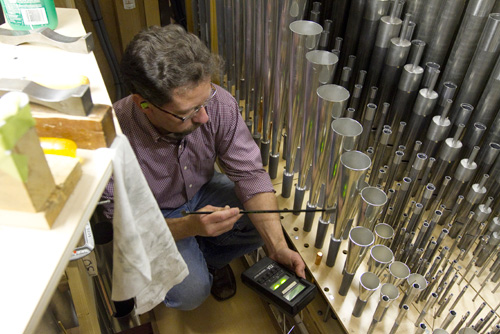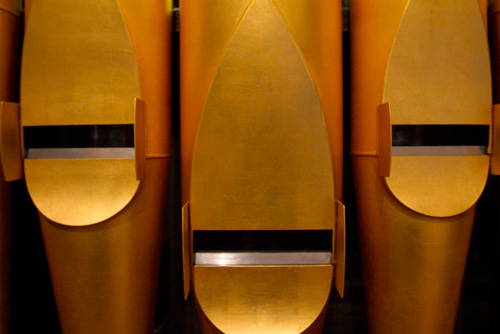Photos by Jon Chase/Harvard Staff Photographer
Piping up, to good effect
After years of planning, a new organ will fill the Memorial Church with music
Charles Brenton Fisk’s daughter once said that her father was “dedicated to his work the way that some people are dedicated to a true love.” The Memorial Church’s new organ is a product of that devotion.
In 1943, the U.S. government tapped Fisk, then an 18-year-old Harvard student, to work for physicist Robert Oppenheimer in the bomb-trigger division of the Manhattan Project. Later, Fisk studied nuclear physics at Stanford University, but soon the onetime chorister at Christ Church in Cambridge traded his lab talents for his workshop skills to craft some of the most complex musical instruments.
Eventually another Harvard man, the spiritual heart of the University for more than 40 years, noticed Fisk’s artistry. An accomplished organist himself, the Rev. Peter J. Gomes became the driving force behind a donor-funded, $6 million effort to provide his church with the type of sound it deserved.

The dream of Gomes, who died a year ago, will be realized this Sunday when the new Fisk organ, Opus 139, is officially unveiled. The inauguration begins a series of events showcasing the 16-ton instrument.
A 2005 committee led by Gomes agreed that two organs instead of one were needed to fill the church’s space adequately, one for the intimate Appleton Chapel, the other for the main body of the church. For the larger instrument, they turned to C.B. Fisk Inc., the mechanical-tracker organ company founded by Fisk, whose Opus 46 had been in the chapel since 1967.
“Fisk epitomizes the classical principles of organ building,” said Christian Lane, associate University organist and choirmaster. “Through a well-constructed, mechanical-action touch … you are really just controlling the wind in this amazing and voluptuous way.”
In 2010, the Opus 46 was dismantled for shipping to its new home, a Presbyterian church in Austin, Texas. A 1929 Skinner Organ Co. organ took its place in the chapel.
Meanwhile, the new Fisk organ slated for the church’s rear gallery was nearing completion in a town more famous for its fishing fleet than for complicated musical machines. Only a small mahogany sign with the words “C.B. Fisk” identifies the workshop in an industrial park in Gloucester, Mass. Inside, dedicated artisans draft and draw, solder and saw. Small models of every organ the company has made are perched high on ledges scattered around the space. The models are a vital step in the creative process that begins with hand-drawn sketches and ends with sophisticated, three-dimensional computer designs.
There’s a collegial ethos at the workshop, a Fisk hallmark. When there is a technical problem, the workers gather to discuss a solution. A reporter’s inquiry about business titles earns chuckles and the response: “We don’t pay too much attention to that kind of thing.”
The employees are a mix of the mechanical and the musical, the methodical and the meticulous. A crafter of organ reed pipes is, fittingly, a clarinetist. Another worker made his own cello. There are drummers and guitarists, former boatbuilders, cabinetmakers, engineers, and freelance photographers. Above all, they are craftspeople who love working with their hands.
Fisk, the story goes, liked to call his colleagues “blue-scholar workers.”
“He was the most brilliant man I ever met,” said Greg Bover, the company’s vice president for operations, who is also project manager for the Memorial Church installation.

At Harvard one recent afternoon, Michael Kraft, the company’s head reed voicer, was regulating the tone on some of the organ’s 3,049 pipes, the smallest of which stands only half an inch, and the largest 32 feet. The painstaking task takes months, for good reason. Tuning the organ only affects the pitch, explained Kraft, while the voicing process gives the instrument its distinct sound.
“It’s giving each pipe its voice … we are talking about color, timbre, speech, all of the different qualities of the sound. That voicing process is only done once.”
Kraft, who has a master’s degree in organ performance from the New England Conservatory, then tested his work by playing a little Johann Sebastian Bach. The sound was magnificent.
Harvard’s Gund University Organist and Choirmaster Edward Jones reflected on Gomes’ musical legacy. Thanks to the insistence of the longtime Pusey Minister and Plummer Professor of Christian Morals, the organ’s pipes are sheathed in a brilliant 22-carat gold.
“It’s a wonderful instrument. It’s musically eclectic and can do a large range of things,” said Jones. “The construction and architecture of the organ is so beautiful and has been so well thought out that it looks to my mind like it should have been here all along. I hope Peter is looking down with a big smile on his face.”




